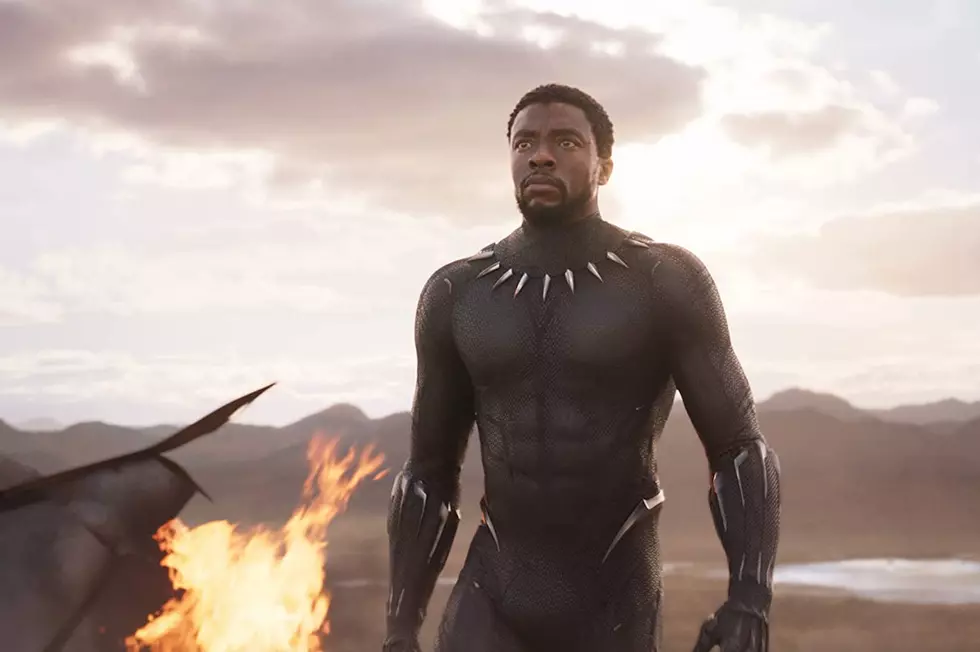
I’m David: Welcome to Black History Month

I've been black since the day I was born, reading comics since before I could properly read, writing about comics since 2005, writing about the intersection of race and comics since 2006, and purposefully writing about the intersection of race and comics since 2007. I spent February 2008 through February 2011 doing a series of daily, and then frequent, posts on black history in comics, specifically mainstream comics. I've done black history-oriented pieces for Marvel.com, CBR ran a selection of my posts one year, and ComicsAlliance has run some commentary from me on the subject, too.
I'm David. This is my new weekly column. I want to take you on a brief walk through black history.
One hundred years ago this October, George Herriman launched Krazy Kat, a comic strip about Krazy, an impressively innocent cat; Ignatz, a brick-throwing mouse; and their colorful collection of cartoony friends like Gooseberry Sprig, the Duck Duke, and Bum Bill Bee, a hobo bee. Depending on who you ask, Krazy Kat is either the best comic ever or the bestest comic ever. It has a simple high concept -- there is a cat, there is a mouse, there is a mouse throwing a brick at a cat -- but the execution, much like Charles Schulz's Peanuts or Bill Watterson's Calvin & Hobbes, goes so far above and beyond the call of duty that you can't help but be entranced by Herriman's work.
Comics critic Joe McCulloch once described Krazy Kat to me as something closer to poetry than prose, and I agree. There's an airy feel to these strips, and Herriman's idiosyncratic writing is lyrical more than it is literal. Krazy's patter is rife with misspellings, meant to illustrate Krazy's own strange way of talking, but it doesn't come across as forced or weird. It simply is, and you can take it or leave it. If you choose to take it, you'll experience some of the funniest comics ever put to paper. If you choose to leave it, you'll miss out on some of the funniest comics ever put to paper.
(click to enlarge)
All-Negro Comics came a few decades later. Word is that two issues were produced, but only the first was ever released. The comic debuted in 1947 and was the brainchild of Orrin C. Evans, an influential and historically significant journalist. The comic came with an interesting mandate: it was for us, by us. Instead of just being a fun anthology comic like other titles on the shelves, All-Negro Comics was meant as a work of social responsibility, as well. In the words of Orrin C. Evans, president of All-Negro Comics, Inc., "All-Negro Comics will not only give Negro artists an opportunity gainfully to use their talents, but it will glorify Negro achievements."

Glorifying Negro achievements isn't just a matter of spotlighting one or two people from history. It's about legitimizing -- or at least paying homage to -- the full spectrum of the Negro experience. It's about giving time to the rich and the poor, the country and the urbane. It's about black being beautiful, and representing every shade -- or several shades, more realistically -- of blackness.
All-Negro Comics was intended to serve as a tonic for its black readers. It would show the children that life is more than Jim Crow and lynchings, and in so doing, enhance our future. Our pop culture is defined by us, yes, but it also defines us. It's important to have that foundation, to be defined as something other than the villain, the token, the sidekick, or the absent voice. All-Negro Comics slotted black voices into the detective story, the adventure tale, the fairy tale, the slice of life tale, and even the jungle tale, one of the most reprehensibly and indelibly offensive genres out. It's a small move, just a shift in perception and point of view, but a valuable one.
Billy Graham came later still. He was born in 1935, died in 1999, and was "just" a comics artist like Muhammad Ali is "just" a boxer. He touched every single issue of the first run of Luke Cage, Hero for Hire, and his work was invaluable in defining the character and mannerisms of one of the longest-lasting black heroes. He made a character that could have been absurd in the wrong -- or even the right -- hands into someone you could believe in.
(click to enlarge)
Graham's work on the Black Panther proto-graphic novel Panther's Rage, written by Don McGregor, is what elevated him to my own personal pantheon, though. He owns the look of the Panther, even more than co-creator Jack Kirby. Panther's Rage was about failure, misery, and hard-won success, and Graham delivered. Even if you somehow manage to discount the fact that Panther's Rage is an all-time classic and historically important in terms of comics storytelling, you can't deny that his splash pages were stunning, his integrated titles were impressive, and his approach to acting and body language were incredible.
There are a lot of guys we miss when we talk about black history. They weren't the first to do something, or the most popular. They were just really good at what they did, and they quietly did their thing. These are our mothers and fathers who hustled so their kids could believe in a Santa Claus, our grandfathers and grandmothers whose strength gave our parents spines of steel in the face of terrorism.
Twenty years ago this month (2/24/1993, to be specific), Denys Cowan, Michael Davis, Derek Dingle, and Dwayne McDuffie unleashed Hardware #1 on the comics industry. Written by McDuffie and drawn by Cowan, Hardware #1 introduced Curtis Metcalf, a gifted young scientist whose smarts gave him opportunities that his skin color and background did not. He was groomed by Edwin Alva, the head of a major corporation, as he grew up. Metcalf's college career was paid for with one caveat: come work for Alva.
Metcalf grew up and did just that. When he asked to share in the massive profits he was bringing to his mentor's company, he was informed that he was not family, merely an employee. "You are not respected, Curtis," said his mentor. "You are merely useful."
Hardware isn't just a parable about workers' rights. It's about taking responsibility for your actions, owning your creations, and learning to be your own man. It's about the consequences that come with having a history, be they good or bad.

Milestone was bigger than Hardware, but I like how Hardware itself is a little microcosm of what Milestone represents. McDuffie, Cowan, Dingle, and Davis didn't get a chance to make their own mark on the world while they worked at Marvel and DC. They did the smart thing: they left and then they created work on their own terms. Call it "separate, but better."
Today, Marvel and DC are still exploring where and how their black characters fit into their universe -- from a biracial Ultimate Spider-Man to a newly A-list Cyborg in Justice League to new push for the Black Panther -- and doing it largely without the input of black writers. The first black people to get to guide the destiny of the X-Men heroine Storm, the destiny of what is arguably the biggest black character in comics, were Eric Jerome Dickey and Reggie Hudlin in 2006, 31 years after she was created. No black woman has gotten a chance to sit down and redefine the character for a new era. As near as I can tell, about 18 black writers have ever gotten a chance at making a stamp on Marvel and DC at all.
While they're still gatekeepers of a certain type, Marvel and DC don't matter as much as they did in the past. Spike Trotman, creator of Templar, AZ, is a black woman. She's doing things her way, from her webcomic to Iron Circus Comics, her publishing project. Marguerite Abouet, writer of the Aya series published by Drawn & Quarterly, has written a series of comics about what life is like for a young black girl who lives thousands of miles away from my hometown. Kyle Baker and Jamal Igle, both artists who've spent a lot of time working with Marvel and DC, have set out on their own quests to not just fully control their work, but to make the type of work they want to make. Keith Knight's definitely the funniest dude in your newspaper.
Black History Month exists to address an inequality. It's an institutional inequality, rather than a personal one, but it's an inequality nonetheless. A side effect of the media in America being controlled by and aimed at one demographic is that any other demographic is left feeling like a second class citizen. Black History Month exists to partially fill the gap. It's to remind you that black people have been in America for centuries, that we are a vital and vibrant part of the culture, and that, more than anything else, we exist.
We've always been here. We're not going anywhere.
I'm answering one question a week. First up is a familiar face:
Chris Sims asks: Let's see you write 2000 words about the Batmobile. BALL'S IN YOUR COURT, BROTHERS.
This isn't even a question. Can you believe the nerd of this guy? If you have a real question, not whatever this is, let me know by leaving a comment or hitting me on Twitter @hermanos. Let's talk comics, movies, music, video games... anything goes.
More From ComicsAlliance








![A New Team Bands Together In ‘Black Panther & The Crew’ #1 By Coates, Harvey, And Guice [Preview]](http://townsquare.media/site/622/files/2017/03/Black_Panther_The_Crew_1_Featured.jpg?w=980&q=75)



